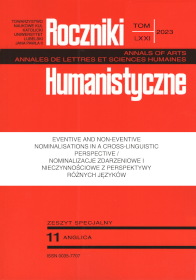Action Nominal Constructions and Their Use in a Swedish COVID-19 Corpus
Action Nominal Constructions and Their Use in a Swedish COVID-19 Corpus
Author(s): Maria RosenbergSubject(s): Language and Literature Studies, Theoretical Linguistics, Morphology
Published by: Towarzystwo Naukowe KUL & Katolicki Uniwersytet Lubelski Jana Pawła II
Keywords: deverbal nominalisations; word-formation; morphological constructions; compounding; lexeme-based approach
Summary/Abstract: Swedish has two main types of action nominal constructions (ANCs), either compounding or phrasal (incorporating or nominal, in Koptjevskaja-Tamm 1993), which contain deverbal nouns in -ande or -(n)ing, along with dependent elements. This study investigates Swedish ANCs in use, based on a limited data set from a COVID-19 corpus. It adopts a lexeme-based approach, where deverbal nouns (simplex action nominals), whether including -ande or (n)ing, are morphological constructs and contain a verb lexeme, specified for a list of arguments and an event structure. The study focusses on two questions: to what extent do the two suffixes occur in the compounding versus phrasal ANCs, and to what extent and by what means are the arguments of the verbal base expressed in the compounding versus phrasal ANCs. The data of 328 ANCs (type) show that compounding ANCs predominate over phrasal ANCs, whether combined with -ande or -(n)ing, and that -(n)ing is much more frequent than -ande. As for the expression of arguments, the compounding ANCs contain equally often a modifier (similar to NN-compounding) or an Arg2/internal argument, whereas the phrasal ANCs more often express the Arg2. The Arg1/external argument tends to be expressed as a preposed genitive in one out of ten cases in both compounding and phrasal ANCs. Within a lexeme-based account, we can speak of a gradual transition from morphological constructions, more typically primary compounds (noun-noun) and less typically deverbal compounds (such as compounding ANCs), over to syntactic constructions (such as phrasal ANCs). In conclusion, the study suggests that compounding ANCs are the preferred option in contemporary Swedish for both suffixes, with compounding ANCs, in particular those with -(n)ing, bordering on NN-compounding. Given that both phrasal and compounding ANCs with -ande or -(n)ing occur, albeit to different extents, competition between the morphological and syntactic patterns remains unresolved.
Journal: Roczniki Humanistyczne
- Issue Year: 71/2023
- Issue No: 11S
- Page Range: 203-223
- Page Count: 21
- Language: English

